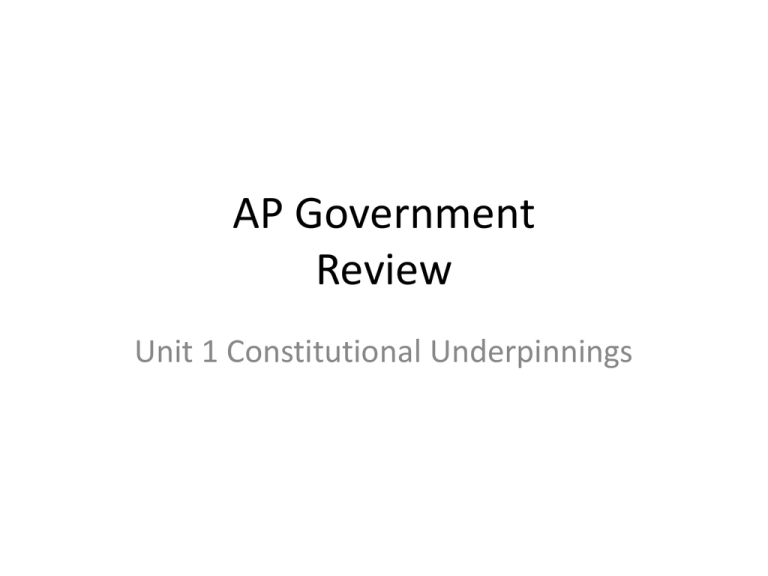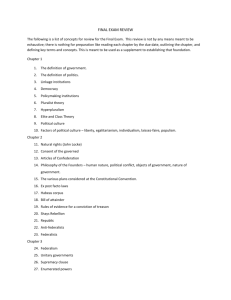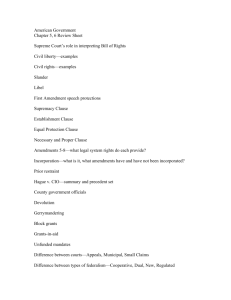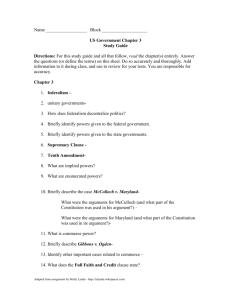AP Government Review - Glenelg High School
advertisement

AP Government Review Unit 1 Constitutional Underpinnings Tuesday September 24, 2013 • OBJ: SWBAT understand Unit I through review. • Drill: What is bipartisan? Why is it important to this issue? What does it say about the overall feeling of the government? • HW: Study for Unit I Test Homework • Which event/term did you choose and why? Goals of the US Constitution • • • • • • Create a strong union of states Establish justice Preserve Domestic Order Provide for the common defense Promote general welfare Promote individual freedoms Constitution Remedies the Articles of Confederation • Creates Federalism – • • • • A balance between the national and state governments National government could tax Congress could regulate commerce between the states and foreign nations Article II created an executive department to enforce laws Article III created a national judiciary with a Supreme Court and lower courts established by Congress Constitution Remedies the Articles of Confederation • Only the national government could coin money • States are represented based on population in the House of Reps and equally in the Senate • Bills need a simple majority in the House and Senate • 2/3 of Congress and 3/4of the states are necessary to amend the Constitution Basic Principles of the Constitution • • • • • Limited government Popular sovereignty Separation of powers Checks and balances Federalism Amendments • The Constitution has been formally amended 27 times. – Please know all the amendments • The first 10 amendments are known as the Bill of Rights Informal Amendments to the Constitution • • • • Legislative action: Judiciary Act of 1789 Executive actions: Executive orders Judicial review: Marbury v. Madison Custom and usage: No 3rd term for Presidents Federalism • Delegated powers – Expressed powers given to the national government • Implied powers – Powers that may be reasonably inferred from the Constitution (Necessary and Proper Clause) • Inherent powers – Powers that exist from the national government because the government is sovereign • Concurrent powers – Belong to both the states and national governments • Reserved powers – Powers that belong to the states (Amendment 10) Federalism In Practice • Interstate Relations – Full faith and credit clause: states are required to recognize the laws and legal documents of other states – Privileges and immunities clause: states are prohibited from unreasonably discriminating against residents of another state – Extradition: states may return fugitives to states which they fled – Interstate compacts: states may work together to solve regional problems National Supremacy • Article IV Supremacy Clause – McCulloch v. Maryland (1819) Federal law is supreme over state law – Gibbons v. Ogden (1824) National supremacy over interstate commerce Federalism Today • Dual Federalism (1789-1932) – Layer cake federalism: National and state have power within their own sphere of influence • Cooperative Federalism (1932-1968) – Marble cake federalism: National and state work together • New Federalism (Nixon, Reagan, Bush 41) – Devolution of national power to the states Fiscal Federalism • Grant in aid – Money and resources provided by the national government to state and local projects and programs • Categorical grants – Grants that have specific purpose defined by law • Block grants – General grants which can be used for a variety of purposes • Unfunded mandates – Requirements which are imposed by the national government on the state and local governments Questions? • Review Jeopardy. • Get into Five teams. • Each team will be given a chance to answer one question if they do not get it correct it will be opened up to the next team, and so on. Wrap Up • What is the overall theme of Unit I? How would you describe it in 1-2 sentences?








